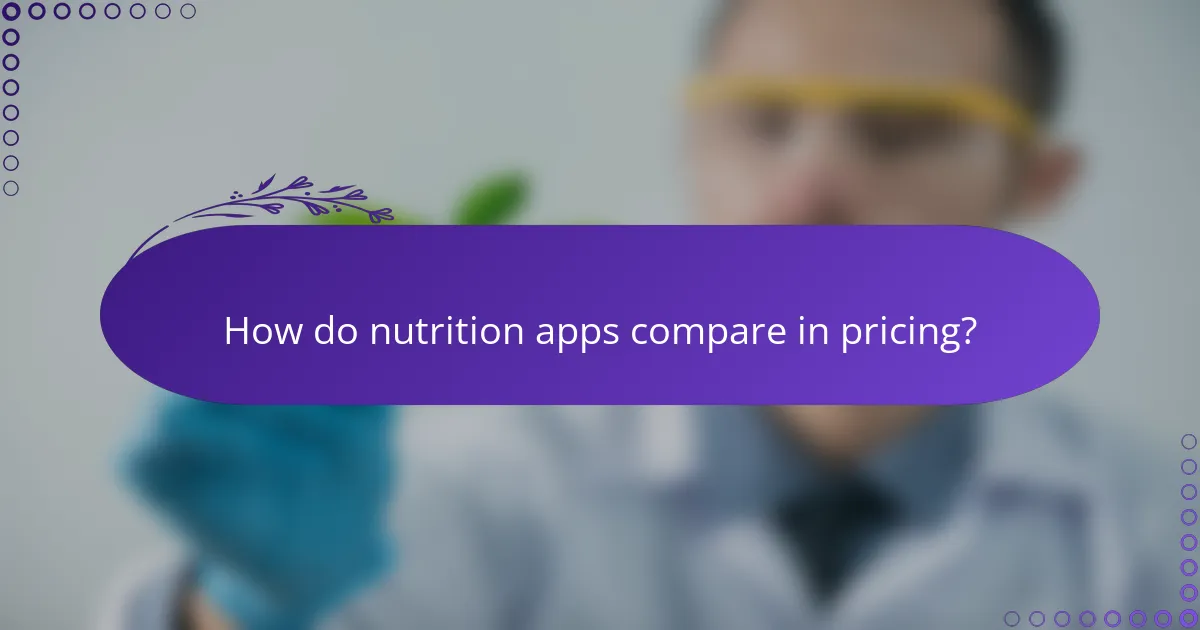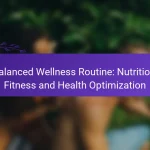Nutrition apps have revolutionized the way individuals approach their dietary habits by offering personalized recommendations and tracking features tailored to user data. These user-friendly tools not only help monitor food intake but also set goals and analyze eating patterns, making it easier to achieve specific dietary objectives. With consistent use, many users experience improved eating habits and successful weight management.

How do nutrition apps personalize user experience?
Nutrition apps personalize user experience by leveraging user data to tailor recommendations, meal plans, and tracking features. This customization enhances user engagement and helps individuals meet their specific dietary needs more effectively.
AI-driven meal recommendations
AI-driven meal recommendations analyze user preferences, dietary restrictions, and nutritional goals to suggest meals that align with individual needs. These algorithms can consider factors such as calorie intake, macronutrient ratios, and even seasonal ingredients.
For example, if a user is looking to increase protein intake while reducing carbohydrates, the app can suggest high-protein recipes that fit these criteria. This dynamic approach allows for a more relevant and enjoyable meal planning experience.
User dietary preferences
User dietary preferences play a crucial role in personalizing nutrition apps. Users can input their likes, dislikes, allergies, and dietary choices, such as vegetarian or gluten-free, which the app uses to filter meal suggestions and tracking options.
By accommodating these preferences, apps can enhance user satisfaction and adherence to dietary plans. For instance, a user who dislikes fish will not receive seafood recipes, ensuring that meal suggestions are both appealing and practical.
Customizable nutrition goals
Customizable nutrition goals allow users to set specific targets based on their health objectives, such as weight loss, muscle gain, or improved energy levels. This feature enables users to adjust their calorie intake and macronutrient distribution according to their personal aspirations.
Users can typically set daily goals for calories, protein, fats, and carbohydrates, which the app tracks over time. This flexibility helps users stay focused and motivated, as they can see their progress and make adjustments as needed to stay on track with their health journey.
![]()
What are the best nutrition apps for tracking?
The best nutrition apps for tracking are user-friendly tools that help individuals monitor their food intake, set goals, and analyze their dietary habits. Popular options include MyFitnessPal, Lose It!, and Cronometer, each offering unique features to enhance personal nutrition management.
MyFitnessPal
MyFitnessPal is a widely used nutrition app that allows users to log their meals and track their calorie intake easily. It features a vast database of foods, including many restaurant items, making it convenient for users to find and record what they eat.
One of its strengths is the ability to set personalized goals based on weight loss or maintenance objectives. Users can also connect with friends for motivation and support, which can enhance accountability.
However, some users may find the free version limited in features, such as advanced nutrient tracking and ad-free experience, which are available in the premium subscription.
Lose It!
Lose It! focuses on helping users lose weight by tracking food intake and exercise. The app allows for easy logging of meals and offers a barcode scanner for quick entry of packaged foods.
Users can set specific weight loss goals and receive personalized recommendations based on their dietary preferences. The app also includes a social feature where users can join challenges or connect with friends for added motivation.
While the app is effective for tracking calories, some users may miss more detailed nutrient analysis, which is less comprehensive than other apps.
Cronometer
Cronometer is a nutrition tracking app that emphasizes detailed nutrient tracking, making it ideal for users focused on specific dietary needs. It provides comprehensive data on vitamins, minerals, and macronutrients, which is beneficial for those with health conditions or specific dietary goals.
The app allows users to log food intake and track exercise, providing a holistic view of their nutrition. It also supports custom foods and recipes, enhancing personalization.
However, the interface may feel less intuitive for some users compared to other apps, and while it offers a free version, advanced features require a subscription.

How effective are nutrition apps in achieving results?
Nutrition apps can be highly effective in helping users achieve their dietary goals by providing personalized tracking and feedback. Many users report improved eating habits and weight loss success when consistently using these apps.
Improved dietary habits
Nutrition apps encourage better dietary habits by allowing users to log their food intake and monitor nutritional values. This tracking helps individuals become more aware of their eating patterns and make healthier choices. For example, users might discover they consume excessive sugar or sodium, prompting them to adjust their diets accordingly.
Many apps offer features like meal planning and recipe suggestions tailored to individual preferences and dietary restrictions. This personalization can lead to more balanced meals and a greater variety of foods, enhancing overall nutrition.
Weight loss success stories
Numerous users have successfully lost weight using nutrition apps, often reporting reductions of 5-15% of their body weight over several months. These apps help users set realistic goals and provide tools to track progress, which can be motivating. Success stories often highlight the importance of consistency and accountability in achieving weight loss.
Some apps include community features where users can share their journeys and support each other, further enhancing motivation. Engaging with a community can provide additional encouragement and tips that contribute to long-term weight management.
Behavioral change support
Nutrition apps support behavioral change by incorporating features that promote mindful eating and self-reflection. Many apps use reminders and notifications to encourage users to stay on track with their goals. This consistent engagement can help users develop healthier habits over time.
Additionally, some apps utilize gamification techniques, such as challenges and rewards, to make the process more enjoyable. By turning healthy eating into a game, users may find it easier to stick with their dietary changes and see lasting results.

What features should you look for in a nutrition app?
When selecting a nutrition app, focus on features that enhance personalization, tracking, and results. Key elements include food tracking capabilities, integration with fitness devices, and community support to keep you motivated.
Barcode scanner for food tracking
A barcode scanner simplifies food tracking by allowing you to quickly log items by scanning their packaging. This feature saves time and reduces the hassle of manually entering nutritional information.
Look for apps that have extensive databases to ensure accurate tracking of various products. A good app should recognize a wide range of barcodes, including those for local or specialty foods.
Integration with fitness trackers
Integration with fitness trackers enables seamless synchronization of your nutrition and exercise data. This feature helps you monitor your overall health by correlating calorie intake with physical activity.
Choose apps that connect with popular fitness devices, such as Fitbit or Garmin, to enhance your tracking experience. This integration can provide insights into how your diet impacts your fitness goals.
Community support and challenges
Community support and challenges can significantly boost your motivation and accountability. Many nutrition apps offer forums, groups, or challenges that allow users to share experiences and tips.
Participating in challenges can make your nutrition journey more engaging. Look for apps that host regular events or competitions to encourage healthy habits and foster a sense of community among users.

How do nutrition apps compare in pricing?
Nutrition apps vary significantly in pricing, ranging from free options with basic features to premium subscriptions that offer extensive functionalities. Users should consider their specific needs and budget when choosing an app, as the cost can influence the range of features available.
Free vs. premium features
Free nutrition apps typically provide essential tracking capabilities, allowing users to log meals and monitor calorie intake. However, premium features often include personalized meal plans, advanced analytics, and integration with fitness trackers, enhancing the overall user experience.
For example, a free app might limit users to basic food logging, while a premium version could offer detailed nutrient breakdowns and personalized coaching. Users should assess whether the added features justify the cost based on their individual goals.
Subscription costs for top apps
Subscription costs for popular nutrition apps usually range from around $5 to $15 per month, depending on the features offered. Some apps may provide discounts for annual subscriptions, which can lower the monthly cost significantly.
For instance, apps like MyFitnessPal and Noom have tiered pricing structures, where users can choose between free access and various premium plans. It’s advisable to compare these costs against the features provided to determine the best value.
Value for money analysis
When evaluating the value for money of nutrition apps, consider the features that align with your dietary goals. A premium app may be worth the investment if it offers personalized meal plans and coaching that can lead to better results.
Additionally, users should look for trial periods or money-back guarantees that allow them to test premium features before committing. This approach helps ensure that the app meets their needs and provides sufficient value for the price paid.

